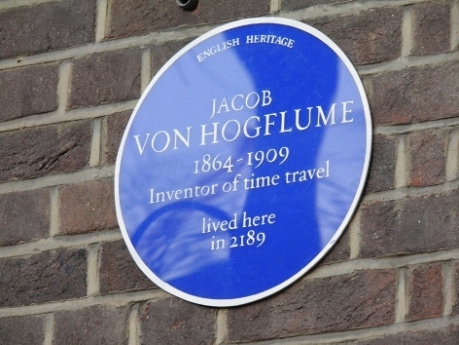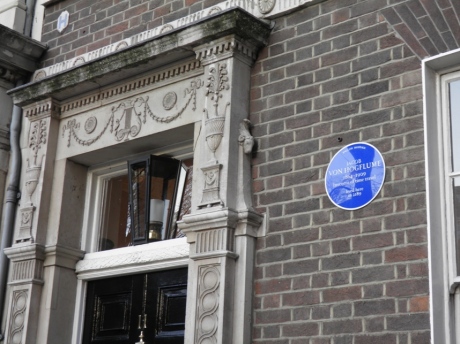Jacob Von Hogflume’s Blue Plaque
January 31, 2013
In February 2012, a blue plaque appeared on 11 Golden Square, Soho.
It’s not there anymore and neither was it up for long, which is a shame. It commemorated…well, have a look.
The plaque was the work of Dave Askwith and Alex Normanton, who made the signs look as authentic as possible and then surrepticiously secured them to buildings. Some lasted weeks, some months.
They released a book of their witty, realistic-looking work called Signs of Life in 2005. Now out of print, it’s available here on Amazon, or here on Abebooks if you can’t stomach non-tax-paying conglomerates.
It’s in the grand tradition of fake English Heritage signs which seem to be attracted to Soho – for many years, one was pasted to a window in Berwick Street reading “Tom Baker, Bespoke Tailor…worked here but lived round the corner” and for a while, Gavin Turk’s was displayed inside the Groucho Club – but I think this is my favourite. I’m all for it being made permanent.
A second Askwith-Normanton sign was on display a littler further down the wall when I took these photos. It too has now long gone.
The house of Jack The Ripper
May 6, 2011
It might be more proper to place a question mark at the end of that headline, but, according to Stephen Knight’s Jack The Ripper: The Final Solution (1985), 74 Brook Street, just two minutes away from Oxford Street and opposite Claridge’s, was once the home of London’s most infamous murderer.
Knight first identified the Victorian surgeon William Withey Gull (1816-1890) as Jack the Ripper in his book, and his hypothesis was later adopted by Alan Moore for the tremendous graphic novel From Hell (which was also a less tremendous film.)
 Dr William Withey Gull, c.1860
Dr William Withey Gull, c.1860
Educated at Guy’s Hospital (where he remained throughout his professional career) Gull’s medical reputation has been entirely outstripped by the clamour of the Ripperologists. He coined the name ‘anorexia nervosa’, advanced understanding of paraplegia and Bright’s disease, argued that women should be encouraged to enter the field of medicine, and was known for his ceaseless work in treating patients at any time of day or night.
Gull’s surprisingly modern medical outlook was summed up in his Published Writings: “Never forget that it is not a pneumonia, but a pneumonic man who is your patient. Not a typhoid fever, but a typhoid man.”
In 1871, Gull became Physician-in-Ordinary to Queen Victoria’s son Albert (then Duke of Wales and later Edward VII) and successfully treated him for typhus. With nary a full-stop in sight, The Times reported on Gull’s work with the Prince in December 1871:
In Dr. Gull were combined energy that never tired, watchfulness that never flagged ; nursing so tender, ministry so minute, that in his functions he seemed to combine the duties of physician, dresser, dispenser, valet, nurse, – now arguing with the sick man in his delirium so softly and pleasantly that the parched lips opened to take the scanty nourishment on which depended the reserves of strength for the deadly fight when all else failed, now lifting the wasted body from bed to bed, now washing the worn frame with vinegar, with ever ready eye and ear and finger to mark any change and phase, to watch face and heart and pulse, and passing at times twelve or fourteen hours at that bedside.
Created a Baronet the following year (he took the title 1st Baronet of Brook Street), Gull was consequently appointed Physician Extraordinary and subsequently Physician-in-Ordinary to Victoria. It is not likely he ever treated the Queen; there were four Physicians-in-Ordinary and for all but one of them it was effectively an honorary position.
Gull died at 74 Brook Street in January 1890 after a series of strokes. The Times reported his death.
We regret to announce that Sir William Gull died at half-past 12 yesterday at his residence, 74, Brook-street, London, from paralysis. Sir William was seized with a severe attack of paralysis just over two years ago while staying at Urrard, Killiecrankie, and never sufficiently recovered to resume his practice.
On Monday morning, after breakfast, he pointed to his mouth as if unable to speak. His valet, who was in the room, did not quite understand what was amiss, but helped him into the sitting-room. Sir William then sat down on a chair and wrote on a piece of paper, “I have no speech.” The family were at once summoned, and Sir William was soon after removed to bed, where he received every attendance from Dr. Hermann Weber, an old friend, Dr. Charles D. Hood, his regular medical attendant, and Dr. Acland, his son-in-law.
The patient, however, soon lost consciousness, and lingered in this state until yesterday morning, when he quietly passed away in the presence of his family. The inquiries as to his state of health during the last two days have been unusually numerous, a constant stream of carriages drawing up at the door.
Gull was buried next to his mother and father’s graves in his childhood hometown of Thorpe-le-Soken in Essex.
If his name was well-known in his lifetime, it was nothing compared to how famous it would become from the 1980s onwards. While a 72-year-old highly-respected baron doesn’t seem the most likely of serial killers, Stephen Knight’s hugely entertaining book argued that Gull was responsible for murdering five women working as prostitutes in the East End in 1888 on the direct orders of the state.
To do justice to the entire murky web of probable presumptions, possibilities and perhapses which make up this conspiracy, there’s nothing as exhaustive and enjoyable as Alan Moore’s From Hell.
The interior of 74 Brook Street even makes an appearance towards the end of Moore’s book, when the medium Robert James Lees leads the police investigator Abbeline to the doctor’s front door. A tired, confused Gull confesses to his crimes. This was just artistic licence on Moore’s part – but considering the entire “William Gull was Jack the Ripper” theory depends almost entirely on artistic licence to keep it afloat, it’s an entirely fitting addition.
Surprisingly there is no plaque commemorating Gull’s time in the house, but there is one the other side of the road, on the house directly opposite 74 Brook Street.
The plaque is not dedicated to Dr Gull or Jack the Ripper, but commemorates some similarly grisly work that, even after all these years, still turns the stomach of all right-thinking people.







